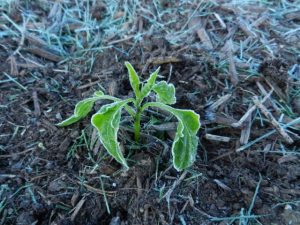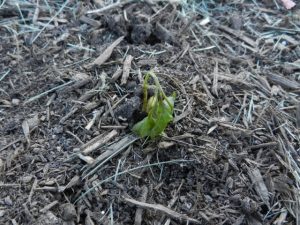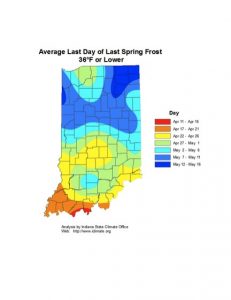
Frost Damage on Young Pepper Transplants
(Photos courtesy of Tom Creswell, Director, Purdue Plant & Pest Diagnostic Lab)
Much of northern and central Indiana – and even patchy, low-lying areas of southern Indiana – experienced frost early this week, causing concern among backyard gardeners. On Monday morning (May 13), the recorded low air temperatures at Purdue Agricultural Centers were 33 degrees F at the northwest Indiana center; 36 degrees at the northeast, north central, and south central centers; 38 degrees at the southeast center; and 42 degrees at the southwest center. Low spots could have been several degrees cooler as frost settled in those pockets.
While this frost was a bit later than average for most areas, it is not as late as you might think. Statically, the last spring frost, defined as 36 degrees F, occurs from May 2-11 for much of the northern half of the state. You can see the more detailed spring frost maps for dates specific to your area on the Indiana graphic. It seems particularly late though, following last year’s season, which was about six weeks earlier than normal. This year has been roughly 1-2 weeks later than normal in bloom time for most landscape plants and fruit trees.
Many gardeners are concerned with newly planted flowers and vegetables. Cool-season plants such as broccoli, cabbage, peas, potatoes and pansies should be just fine. Frost-tender vegetables and bedding flowers such as tomatoes, peppers, petunias and marigolds might have been nipped back, but should be expected to recover. Although soil temperatures have been slow to warm this year, the milder conditions this week should encourage rapid regrowth from surviving foliage buds on tender vegetable crops.

Frost Damage on Young Pepper Transplants
(Photos courtesy of Tom Creswell, Director, Purdue Plant & Pest Diagnostic Lab)
Frost-damaged foliage will initially appear water-soaked but then quickly appear more scorched as the plant cells lose their liquid content. Often only portions of a plant will be affected. Those stems and leaves can be snipped back and, in most cases this year, the growing point of the plant will survive and produce new foliage.
Many fruit plants are in flower or early fruit set now, but the light frost in most areas temperatures remained above the critical-injury level for these plants. Most crops have a really high flower count this year, and a little bit of frost injury might actually help thin the fruit set a bit. Temperatures would have had to drop to 30 degrees F for grapes and to 28 degrees for most other fruit crops, and most areas stayed well above these critical temperatures.
Most landscape plants should have come through just fine from this light frost. We had a much harder freeze in May 2010, which caused considerable damage. The Purdue Plant and Pest Diagnostic Lab has an excellent illustrated article documenting the 2010 damage at www.ppdl.purdue.edu/ppdl/hot10/5-14.html.
Of course, there is always the potential for additional weather challenges, but hopefully we have clear sailing ahead.
